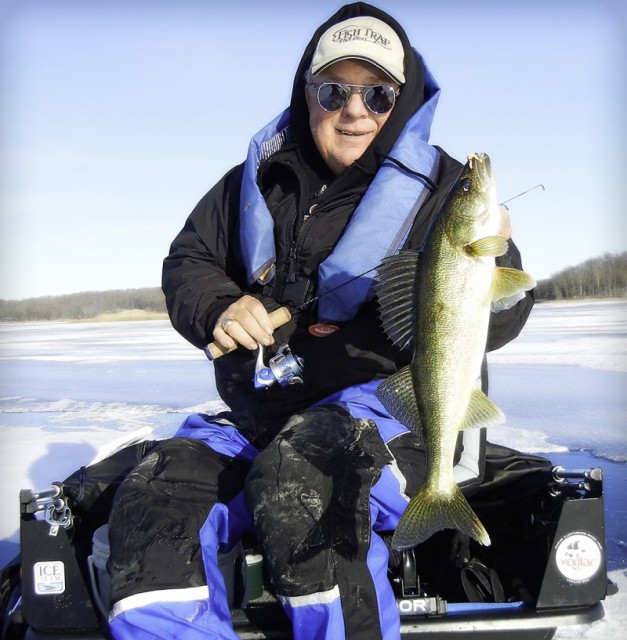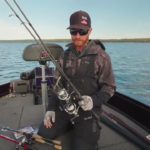Gettin’ the Speed Right
No matter how much you read about presentation, and how badly you want rules to go by, the fact is that fish react differently to possible prey from day to day, even minute to minute. It all depends on what kind of mood they’re in – and how much you’re able to excite them and change their mood.
Mark Strand with Dave Genz
 No matter how much you read about presentation, and how badly you want rules to go by, the fact is that fish react differently to possible prey from day to day, even minute to minute. It all depends on what kind of mood they’re in – and how much you’re able to excite them and change their mood.
No matter how much you read about presentation, and how badly you want rules to go by, the fact is that fish react differently to possible prey from day to day, even minute to minute. It all depends on what kind of mood they’re in – and how much you’re able to excite them and change their mood.
Think about it. A fish is not a robot. Guided by instinct and programmed to deal with opportunities as they appear, at least somewhat curious, it’s common for fish to come over and check out the bait dangling from the end of your line. But will they eat it?
So much depends on what you do with it.
Nobody knows this better than Dave Genz. He’s been obsessing about presentation details (even more than normal) for several years now, digging back in his memory banks for lessons from childhood on, putting together pieces of the puzzle. Constantly testing ideas on what it takes to get fish to bite.
“Honestly, one of the biggest keys to success,” Genz begins, “is to go after fish that are in the mood to bite right now. You can get away with doing something that’s not perfect if the fish wants to eat.”
Indeed, he has been preaching the importance of remaining on the move, seeking out ready biters, for decades. He calls reluctant fish ‘sniffers,’ as in tire kickers, fish that come up to your bait but don’t open their mouths and suck it in. On many days, keeping mobile and picking off the aggressive fish is as far as you have to take it. Doing this puts your bait in front of fish willing to put up with a less-than-perfect presentation, so you end up with a smile on your face.
Complications
Nasty winter weather, large amounts of snow on the ice, slush, and other factors can complicate mobility. On some days and in some places, no matter how badly you want to remain on the move, it’s a tall order.
Mindset and who you have with you can also limit mobility. Some anglers just don’t want to ‘work at it’ real hard, so their personal approach to ice fishing centers around drilling a few holes and hanging out over them, enjoying the day.
At times, you will also be taking people fishing who would not have fun if they had to pack up and move twenty times. To cater to your guests, it can be necessary to plunk your butt down and deal with what the ice fishing gods send your way.
Regardless of the circumstances surrounding your limited-mobility outings, figuring out exactly what the fish want and how they want it presented becomes the key to success.
The same is true for days when, even though you’re mobile, you just can’t find willing biters. Sometimes, all the fish seem finicky. At least the ones you can locate.
Dialing in the Cadence
In the semi-old days, Dave and his friends coined a term for the rapid vibration jigging style they developed. They called it ‘pounding’ and that term is still used a lot to refer to this method.
“Pounding was a good word for it,” says Genz, “because that’s what it is. You’re pounding the rod up and down, even though the up-and-down part of the movement is tiny. Because you’re moving your hand and wrist really fast, the bait looks like it’s vibrating down there, rocking, kicking.”
In short, your bait looks alive, and that very much helps sell the illusion to fish.
“It’s about getting the repetition down,” continues Genz, “so stroke after stroke is exactly the same. That’s what pounding it is all about. But you have to change it if things aren’t working. You can’t just pound it the same every day and expect to catch fish.”
Here we go back to Dave’s early ice-fishing memories. He recalls using a bobber, and ‘jiggling’ the bobber in the hole. He, his father, and others would experiment with how they jiggled the bobber, and it seemed to make a difference in terms of how many bites they got.
“I was still fishing that way,” remembers Dave, “even after I started using a flasher. But this was before I had the good graphite ice rods. I had a bobber on the line and was working the bobber, watching the bobber’s motion and the ripples it was making in the hole.”
Refining the notion of ‘speed’ went on for many years. After Genz developed graphite ice rods, he started fishing the method loosely known as ‘tightlining,’ meaning you have no bobber on the line, just a direct connection between the rod and the lure.
Pounding has been refined a lot, although its essence remains the same: get that bait kicking down there, then try to figure out how fast the fish want it, how high they want each ‘hop’ and so forth. Pat Smith, a creative fisherman who was a big part of the modern ice fishing revolution, recalls spending time just watching Genz execute the pound.
“He’s unbelievable at it,” Smith says. “He was the only person I saw who could actually change the dabble in the middle of working a fish.”
In this last statement is a huge nugget. Smith worked with us on a feature article published in the Ice Team Annual, “Gettin’ Down the Dabble,” where he went into great detail on his personal approach to figuring out “how fish want it” on any given day. He described how he often camps over the first pod of fish he locates and spends extra time experimenting with various degrees of what he calls the dabble – until he’s confident he knows what a lot of fish want at the moment.
Only then does Smith strike off in mobility mode, using his chosen dabble – until it seems to stop working.
In the recent past, Genz has begun calling pounding ‘cadence’ in response to a comment made by In-Fisherman’s Doug Stange. Dave and Rick Johnson were fishing with Stange when Doug noted that the fish have to like what the bait feels like. A reference to the vibrations it gives off in the water, in response to your presentation style.
So these days, the search is for the right cadence – but you can call it pounding or dabble and it essentially means the same thing.
Those who do the same thing with their baits all day long, every time out, are doomed to a life of occasional, random success wrapped around hours and days of nothing. Those who purposely experiment with cadence, notice what presentations bring the most bites, then give the fish what they want, are the ones who always seem to be smiling in fish pictures.





